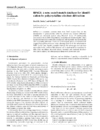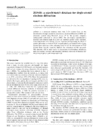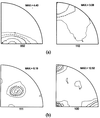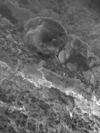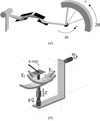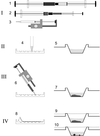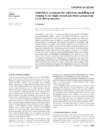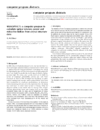issue contents
October 2002 issue

Cover illustration: The crystal structure of titanite, CaTiOSiO4, viewed down the direction of the octahedral TiO6 chains. The full green lines indicate a unit cell of the two-dimensional Ising model, used to predict diffuse scattering intensity observable in layers normal to the chain direction. Ti atoms are shown in green, Ca in light grey, O in blue. The thinner red lines are Si-O bonds, the thick red lines Ti-O1 bonds. Courtesy of T. Malcherek, C. Paulmann, M. C. Domeneghetti & U. Bismayer [J. Appl. Cryst. (2001), 34, 108-113].
research papers
The phase transformation kinetics of high-energy ball-milled monoclinic ZrO2 have been studied in detail by Rietveld powder structure refinement analysis.
An automatic structure determination method based on an interpretation of the Patterson function has been improved by utilizing information on superposition pseudosymmetry, detected using MIF (multiple implication function) groups. A new method of structure determination based on an enantioselective cross-vector function and on a sum atomic minimum superposition is introduced.
Sample-displacement-induced errors are found to arise largely from a change in the diffraction constant, 1/Lsinθ, where L is the total flight path. Modeling of the experimental data indicates that in order to achieve a precision of 10−4, a typical requirement for strain measurements, for a wide angular range of detectors, the sample should be positioned to within ∼0.1 mm of the diffractometer center.
An X-ray based method to quantify cryoprotectant conditions was developed and applied to determine the concentration of glycerol, PEG400, ethylene glycol and 1,2-propanediol necessary to form an amorphous glass at 100 K with the 98 solutions of Hampton Crystal Screens I and II. For solutions requiring high concentrations, cryoprotectant conditions were also determined for (2R,3R)-(−)-2,3-butanediol.
A relational database has been built for the identification of polycrystalline solids by selected area electron diffraction (SAED) and elemental analysis. The effects of double diffraction are fully incorporated into the database through the use of reduced unit cells to calculate d spacings.
A relational database has been built for the identification of single crystals by selected area electron diffraction (SAED) and elemental analysis. The effects of double diffraction are fully incorporated into the database through the use of reduced unit cells to calculate d spacings and included angles.
Using a linear function of the fourth-order invariants of the hkl indices, the dislocation contrast factors have been evaluated numerically and compiled for a number of common hexagonal materials. A procedure is presented to match experimentally determined contrast factor parameters with the numerically obtained parameter values.
Simple optics to decrease beam divergence and improve energy resolution for laboratory X-ray sources
An asymmetric Ge(111) monochromator and two Cr-coated tapered mirrors help to improve the beam quality of a sealed-tube Mo X-ray beam if compared with a pyrolitic graphite monochromator.
Based on the Rietveld profile refinement of neutron diffraction patterns and a new texture analysis method, a quantitative phase analysis method is proposed and examined in the case of artificially produced multiphase alloys having strong textures.
Nanosized polycrystalline mixed rare earth oxides could be synthesized by the sol–gel technique. Replacing Er and Gd by each other introduces slight changes in the atomic coordinates, but changes the lattice parameter non-linearly.
A procedure for computing the resolution function for a time-of-flight hybrid neutron spectrometer with crystal monochromator and chopper using the matrix computation technique is presented. Some ideal focusing conditions deduced by compensating the major contributions to the variances of the scan variable are given; these ideal conditions can be used as a zeroth-order approximation in a numerical optimization procedure.
The asymmetric X-ray peak broadening caused by different types of randomly distributed polarized dislocation dipoles and dislocation walls is investigated. For these dislocation arrangements, the diffraction vector dependences of the asymmetric part of the intensity distributions are determined.
Energy-variable X-ray diffraction at a synchrotron beamline was used in order to control the X-ray penetration depth and thus to study structural parameters in polycrystalline and textured materials with depth resolution. This approach is applied to investigate the depth evolution of microstructure in the nacre layer of bivalvia seashells.
To extend an earlier method of `least-squares' determination of calibration constants that uses only the diffracted intensities and the calculated absorption coefficients of the components to the case of airborne particulates, two possibilities for correcting the measured intensities are explored: either by direct measurement of the sample transmission, or alternatively, by using refined transmission values. In the latter case no experimental values are necessary.
A high-resolution X-ray diffractometer, based on a rotating anode generator, a four-bounce monochromator, a five-movement sample holder and a curved position-sensitive detector and devoted to the study of imperfect materials (mainly oxides and ceramics), is presented. The setup allows rapid acquisition of a reciprocal-space map (in less than 10 h) even for very poorly diffracting materials.
Acceptance diagrams permit the optimum choice of beam elements for three-axis spectrometers.
In this paper the theory of scattering from non-graphitic carbon is revised, appropriate scattering functions are derived for the fitting procedure, and examples of application using an improved method of evaluation are presented.
short communications
Structural and thermal expansion studies of Li2ZrO3 were carried out by recording X-ray powder diffraction patterns at five temperatures: 82, 198, 300, 423 and 573 K. Large anisotropic changes in the lattice parameters were found as a function of temperature, with slight changes in the fractional coordinates of the different atoms, and anisotropic changes in the interatomic distances between the different cations.
A semi-automated microprocedure for setting up membrane protein crystallization trials using lipidic cubic phases is described. In a proof-of-concept experiment, crystals of bacteriorhodopsin were grown under newly found conditions.
computer programs
In the OMNIBUS program, various data reduction methods are offered to the user. Special attention is paid to those which are based on data modelling with a `learnt profile'.
COMPANG is an interactive program that allows the comparison of multiple lists of orientations, for example the peaks of rotation functions.
A Web server is presented that allows one to compare, cluster, and search similar protein structures.
laboratory notes
X-ray beams from a fine-focus X-ray tube can be displaced by appreciable amounts without a serious intensity loss by passing these beams through a glass capillary or polycapillary, the tip of which is translated mechanically under fine control.
computer program abstracts
WINOPTACT, a computer program to enable calculations of optical rotation and refractive indices from a known crystal structure, is described.


 journal menu
journal menu













